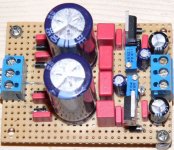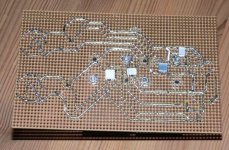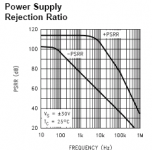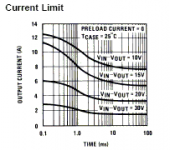slackman said:Hi all,
(nearlly) finisched my PSU-modules. I took protoboards 'cause i didn't want to etch...
Here's a pic...
Did you use the 470nf caps (C3/C4) directly on the regulators' pins?
I can't spot them...

You could have opted for a slightly different layout, as the right side reg is far from the caps...
You should have no problems if you used the 470nf caps under the board, on the regs.
No,
still not. You can imagine that i'm very excited testing the complete system but still not finished the pre... (family, kids -- sigh...)
maybe i first try the amp with a pot in the input to see (sorry 'listen') the result.
I changed the output voltage to a little over 34 volts (2x 470R // agj to out, 2x 3k09 -- adj to ground) to make better use of the trafo (30V sec.)
Michael
still not. You can imagine that i'm very excited testing the complete system but still not finished the pre... (family, kids -- sigh...)
maybe i first try the amp with a pot in the input to see (sorry 'listen') the result.
I changed the output voltage to a little over 34 volts (2x 470R // agj to out, 2x 3k09 -- adj to ground) to make better use of the trafo (30V sec.)
Michael
Nuuk said:Carlos - which GC supplies more current?
One with a 160VA/18v secondaries transformer and 'standard' PSU.
One with a 225VA/25v secondaries transformer but regulated to 27 volt rails.
The regulated PSU is more stable, with no voltage dips.
As much capacitance as you use on the unregulated PSU, it will never be as stable as the regulated. When you get to a certain point it may only be noticeable when taken to extremes, and with very difficult speakers.
I use a regulated PSU on my sub.
EDIT: it's not only a question of current output, as you see.
The weaker trafo on your unregulated PSU example will not be able to produce as much current as on the regulated PSU, where you can use a smaller trafo because you have some voltage headroom, and the LM338 regs can output peaks of 12A.
Nuuk said:Carlos - which GC supplies more current?
One with a 160VA/18v secondaries transformer and 'standard' PSU.
One with a 225VA/25v secondaries transformer but regulated to 27 volt rails.
In know I'm not Carlos
BTW: I've never really understood why adding a regulator to a power supply to artifically restrict its output, for the sake of producing less ripple voltage, was a good idea for class AB amps with high PSRR. It's like damming a river so you can guarantee the same (lower) water flow all year round. I must try a regulated PSU one day to see if I can hear the difference.
grege said:In know I'm not Carlosbut running through the figures of these two power supplies they appear to me to be resonably close in potential output. I'd reckon you should try both and let us all know.
Actually they are quite different.
On the regulated PSU example you have ~35V before the regs and regulate for 27V.
8V headrom, which is fine. The LM338 regs will put out 12A current, when needed.
The voltage output will remain stable, even in difficult conditions, as long as it doesn't drop too much before the regs.
10V headroom would be even better.
The unregulated PSU will have voltage drops, easy to measure when listening to music.
Depending on the speakers and the music type, this voltage drop can be insignificant or enough to affect bass performance.
The trafo in the example is also weaker (160VA).
grege said:BTW: I've never really understood why adding a regulator to a power supply to artifically restrict its output, for the sake of producing less ripple voltage, was a good idea for class AB amps with high PSRR. It's like damming a river so you can guarantee the same (lower) water flow all year round. I must try a regulated PSU one day to see if I can hear the difference.
As you see, that's absolutely not the main point in using a regulated PSU.
Your choice may depend on what you want to do and the speakers you are going to drive.
You can build both the unregulated CRCCS and the Regulated Snubberized PSUs and listen.
In my system both work very well.
carlosfm said:
The unregulated PSU will have voltage drops, easy to measure when listening to music.
Depending on the speakers and the music type, this voltage drop can be insignificant or enough to affect bass performance.
The trafo in the example is also weaker (160VA).
Have you actually measured the PSRR of a chipamp?
I offer no explanations.
However, to me and to many others, good regulated supplies do make a difference even with ics even with high psrr.
The 338 high frequency impedance is the weak point so I'm not surprised that the difference between it and an unregulated is not vastly different. However, at lower frequencies the differences should be clearly audible especially with speakers that need high currents.
However, to me and to many others, good regulated supplies do make a difference even with ics even with high psrr.
The 338 high frequency impedance is the weak point so I'm not surprised that the difference between it and an unregulated is not vastly different. However, at lower frequencies the differences should be clearly audible especially with speakers that need high currents.
Mikett said:The 338 high frequency impedance is the weak point so I'm not surprised that the difference between it and an unregulated is not vastly different. However, at lower frequencies the differences should be clearly audible especially with speakers that need high currents.
They are not vastly different because both are snubberized.
And both have very low impedance up to the Mhz.
Did you notice the title of this thread?
This is not a common (LM338) regulated PSU.
Mikett said:I offer no explanations.
However, to me and to many others, good regulated supplies do make a difference even with ics even with high psrr.
Depends what you consider "high psrr".
At high frequencies it is not so.
And the negative voltage has much lower PSRR.
This is from the LM3886 datasheet:
Attachments
That's exactly the point. The PSRR is much higher at lower frequencies. That leads you to conclude that variation in the PS at low frequencies should not affect the circuit at all! Yet when you listen it does. So what's going on?
Maybe it's the difference in PSRR between the negative and positive that's causing another distortion. When this distortion is removed by regulation the resultant sound is superior.
Pure speculation on my part.
Maybe it's the difference in PSRR between the negative and positive that's causing another distortion. When this distortion is removed by regulation the resultant sound is superior.
Pure speculation on my part.
Mikett said:That's exactly the point. The PSRR is much higher at lower frequencies. That leads you to conclude that variation in the PS at low frequencies should not affect the circuit at all! Yet when you listen it does. So what's going on?
What's goin' on?
You expect to have tight bass when you have voltage sags?
Put your DMM measuring the PSU voltage while cranking up the volume with a piece of music with strong bass.
Look at the DMM and tell me what you see.
Voltage is stable as a rock with the regulated PSU.
With the unregulated PSU, voltage sags more or less depending on the capacitance you are using.
If you also use your ears you'll clearly find a tighter bass with a lower (or none) voltage sag.
And when bass is tight(er) everything else improves.
Join this to PSU with very low impedance up to very high frequencies and you're in for a treat.
carlosfm said:
What's goin' on?
You expect to have tight bass when you have voltage sags?
Put your DMM measuring the PSU voltage while cranking up the volume with a piece of music with strong bass.
Look at the DMM and tell me what you see.
Voltage is stable as a rock with the regulated PSU.
With the unregulated PSU, voltage sags more or less depending on the capacitance you are using.
If you also use your ears you'll clearly find a tighter bass with a lower (or none) voltage sag.
And when bass is tight(er) everything else improves.
Join this to PSU with very low impedance up to very high frequencies and you're in for a treat.
That's true, the voltage is stable as a rock but this is pretty talk.
I don't know if this is the case(LM338) but some regulators have lots of problems in high frequencies... when you need lots of current they simple can't handle it
As I told before, I don't know how the LM338 but the schematic says that the peak is 7A for 0,5ms.
XELB said:That's true, the voltage is stable as a rock but this is pretty talk.
Huh?
XELB said:I don't know if this is the case(LM338) but some regulators have lots of problems in high frequencies...
Aren't you mixing things up???
Regulators have high impedance at high frequencies.
This PSU doesn't.
XELB said:when you need lots of current they simple can't handle it
I bet you can't get to the current limits of this PSU, listening to music, even feeding two chips.
This is a class-AB amp.
Also, it's not by coincidence that I use 2,200uf caps on the amp chips (after the regs).
XELB said:As I told before, I don't know how the LM338 but the schematic says that the peak is 7A for 0,5ms.
From the National LM338 datasheet, page 1:
"The current limit circuitry allows peak currents of up to 12A to be drawn from the regulator for short periods of time."
Max. current: 7A 'min.', 12A 'Typical', on the table with the specs.
You can also check the graph.
Attachments
Look at the output impedance vs frequency chart in the data sheet of the LM338. The ideal output impedance remains " flat" and very low throughout the audio frequency. This one definitely does not exhibit this ideal. In fact I have yet to see a simple three terminal regulator provide that. Capacitors at the output help but as you have discovered causes other problems which snubbers ameliorate but do not eliminate.
That said, all my power amplifiers that I seriously listen to are fully regulated. So I do believe in regulation and the 338/chip amp provides an excellent introduction into correct ampfication that all GC builders should take advantage of.
That said, all my power amplifiers that I seriously listen to are fully regulated. So I do believe in regulation and the 338/chip amp provides an excellent introduction into correct ampfication that all GC builders should take advantage of.
carlosfm said:
Actually they are quite different.
On the regulated PSU example you have ~35V before the regs and regulate for 27V.
8V headrom, which is fine. The LM338 regs will put out 12A current, when needed.
The voltage output will remain stable, even in difficult conditions, as long as it doesn't drop too much before the regs.
10V headroom would be even better.
I think we are looking at this differently. Both PSUs are limited by the capacity of the transformers. Taking into account the regulated PSU wastes power by generating heat, Vin - Vout x current, both PSUs have roughly similiar capacity.
The 12A max rating of the regulator is the max capacity of the regulator before it shutsdown, melts...whatever. The piece of copper wire in a unregulated PSU probably has a max rating of say, 25A. The limitation will be the current the toriod can deliver. Anyway, as you say in another post, it is unlikely these limits will be reached playing music.
From my point of view, the regulated supply has a permanent 8 volt voltage drop which is probably greater than that of the unregulated PSU.
BTW: I'm not saying that a unregulated PSU will sound better or worse than a regulated PSU, cause I don't know.
- Status
- This old topic is closed. If you want to reopen this topic, contact a moderator using the "Report Post" button.
- Home
- Amplifiers
- Chip Amps
- LM338 regulated snubberized PSU for audio amplifiers



